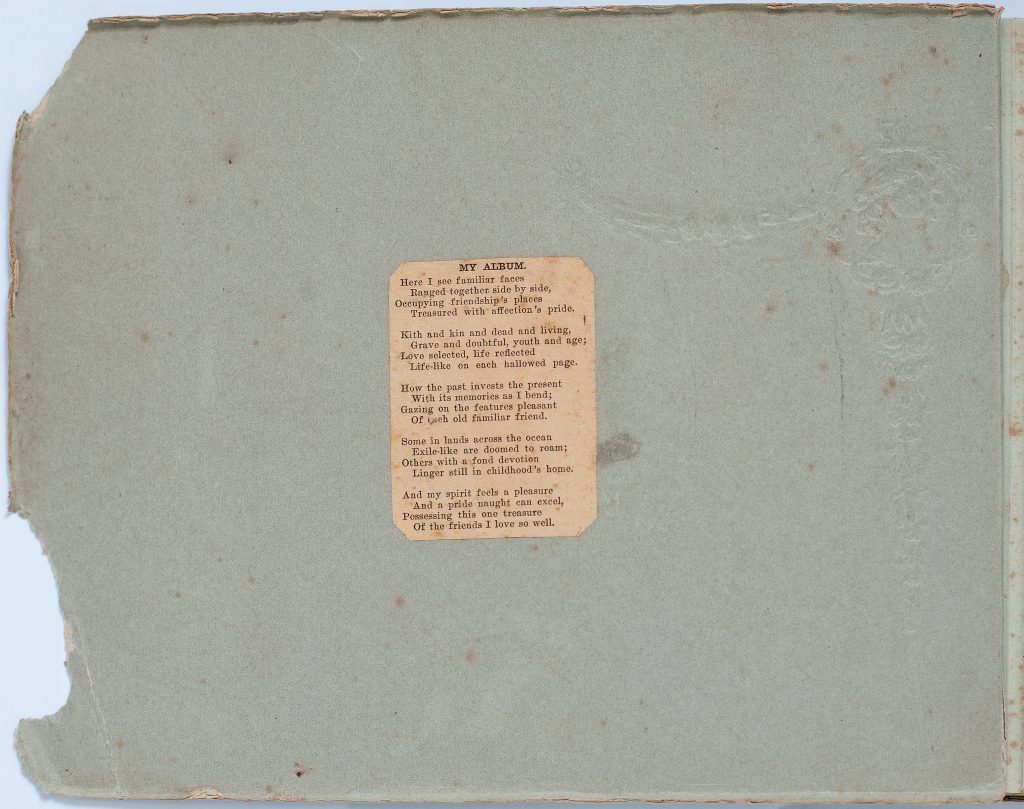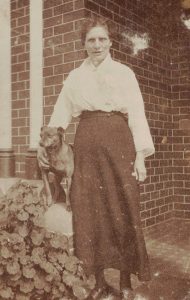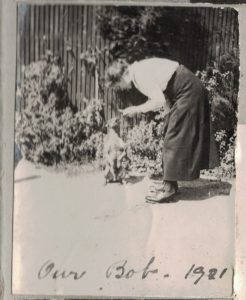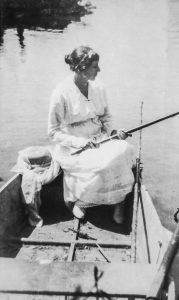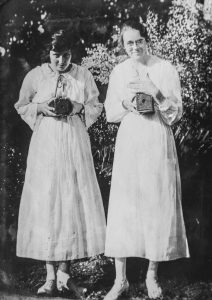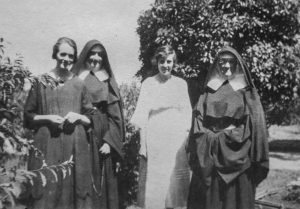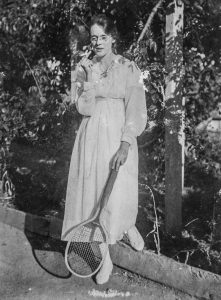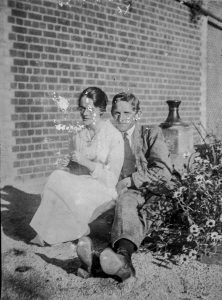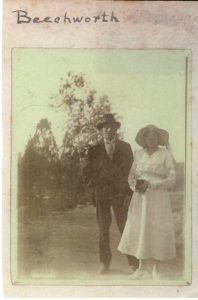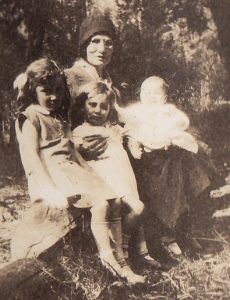I had a conversation in 1995 with my mother about my grandmothers early twentieth century photo album. The photo album was the catalyst for a warm and emotional dialogue between my mother and myself. The photos framed our conversation as they provoked and prompted memories.
My mother shared the story of her grandmother
Grandma was born at a big mansion in the Rutherglen district of Victoria where they still process grapes and make wine. She was born there, one of eight children of German parents… At a young age, she was only eighteen, she married a man who was with the Customs stationed at Wodonga. They were very happy, lovely people.
Margaret with Bob her dog – 1921
The photo of Margaret with her dog Bob was taken on the front porch of her home in Camberwell, Melbourne. She was about 50 years of age. To me, her granddaughter, Margaret appears a strong assertive woman. In the photo she is attired in a long skirt and buttoned up to the neck light coloured blouse. The photo makes Margaret visible to future generations and provides an historical representation of womanhood.
Mary fishing on the Yarra River, Victoria
The aesthetics of this photo appeal to me, her granddaughter. There is a dreamy and surreal feel to the photo. The photograph encapsulates the current, the gentle movement of the river but in juxtaposition the feminine image appears passive, still and intent. Mary is positioned centrally in the photo yet she is located at the bow of the boat so the photographer can capture her whole persona. Mary appears active yet delicate in her soft white clothing against the timber of the boat, and the shadowy backdrop of the water. The photo leaves me, her granddaughter, with a whimsical image of Mary as a young woman. There is an elegance about her that fits with a fairy tale. However, this is only one of the many representations of Mary, my grandmother, which can be gathered from the pages of the album and the stories that are told about her. It is to be remembered that these interpreted images belong as much to the imagination of Mary’s granddaughter as they do to the imaginary past.
Catholic church at Yarrawonga, February 1922
Throughout my grandmother’s photo album, images are dispersed that represent her deep-seated faith in Catholicism. There is a photo of the Catholic church at Yarrawonga in northern Victoria encased by a white picket fence. The fence represents the physical as well as psychical boundaries that Catholicism established to make sure that Catholics remained separate from non-Catholics.
Mary and Vera with Box Brownie cameras
The photo album shows my grandmother Mary’s premarital years of frivolity and fun which she shared with her best friend Vera.
My mother tells Vera’s story
Vera was left an orphan about the age of eight and her Uncle took her, he was a priest. He was the parish priest of Yarrawonga. He took Vera and put her in boarding school with the nuns at Yarrawonga … and they reared her. Then he was moved to… Beechworth at one time. Aunty Mary had a family of boys and she would invite Vera for the holidays. And that’s how they met … They had lovely holidays together during their school days.
Mary and her best friend Vera with nuns at Yarrawonga convent
Mary and her best friend Vera were young women emerging from their schooling and coming out into the broader society. Mary took up a role as a primary teacher and then helped her parents care for relatives at the family home on the Murray River, Victoria. Vera’s life took a different direction. She entered the convent to become a nun. Patricia, Mary’s youngest daughter, commented “She probably entered the convent because there was nowhere else for her to live.” It also most likely offered her a sense of closeness to God and security as a woman. In the end Vera left the convent to live in Armidale, a suburb of Melbourne, and worked until her retirement.
Mary and Vera engaged not only with the subordinate and obedient aspects of growing up Catholic and female but also with the rebellious traits of youth. There are playful photographs that show Mary and Vera as young women dressed in fashionable clothing. One photo is of Vera smoking and in another she is sitting in the lap of a young man appearing light-hearted and flirtatious.
Mary and her husband-to-be Charles at Beechworth, Victoria
Charles returned from World War I and their courtship began. In this photo they are walking along a road in Beechworth, Northern Victoria. My grandmother dressed in white holds her Box Brownie camera. The photo represents Mary during her early adult years as a granddaughter, a daughter, a sweetheart and young modern Melbournian woman. The photo provides me, her granddaughter, with an image of my grandmother at a point of time prior to her taking on motherhood. This snapshot holds so much meaning as it signifies a relationship which was to carry a strong maternal lineage.
Mary – my grandmother with her three daughters
Mary gave birth to three daughters – my mother Marie who was the eldest, Inez who died at the age of 33 and Patricia, whose story is also told in the book.
My mother’s memories are
My mother was a lovely person, a home lover. She always had lots of lovely things in the home. It was a lovely old home that they lived in …
